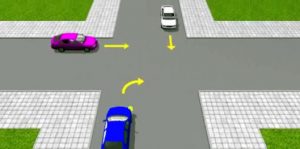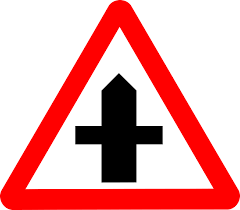To put you to the test, your driving test examiner will try to pack in a variety of road systems to gauge how you cope with these situations. The vast majority of these tests will be in the form of junctions so it is essential to make sure you know the correct and safe way to deal with all types of road junctions. This will make sure you are adequately prepared for your driving test and give you the tools to be a safe driver going forwards.
In this article, we will go over everything you need to know about T junctions and crossroads, including where you need to position yourself on the road and who has priority in specific scenarios.
T Junctions

First up is the T junction. Named for the very fact that they are shaped like a letter T, these are junctions where the road you are on reaches an end and you are required to turn either left or right.
It is important to approach a T junction with care, undertaking the Mirror Signal Position Speed Look (MSPSL) routine as you come up to the junction. The priority here is given to the traffic that is running perpendicular to you at the top of the T, so you need to be checking ahead of you to see how busy the road is.
It is not necessary to always fully stop at a T junction (unless there is a STOP sign of course), as if the road is clear you can carefully join the new road without stopping. Remember to always give way to the traffic on the road you are approaching.
In some T junctions where it is trickier to see the oncoming traffic, it may be necessary to ‘peep and creep’ out of the junction so that you can properly see if it is safe to exit the junction. Here you can use your clutch to edge out and have a thorough check to make sure the coast is clear.
Crossroads

A crossroad is almost certainly going to come up in your driving test so you need to make sure you are well-practiced beforehand with these traffic systems.
At a crossroads, three roads meet at the same road junction. Priority here is given to the major road which the two side roads are joining. If this road is clear, caution still needs to be taken as cars will be coming from the opposite side road and, in this case, some form of priority must be adhered to.
How to approach crossroads
If you are driving on the main road and a crossroad is approaching it is likely that you will see a sign like this:
This sign is warning you that there will be traffic joining the road, so to be extra vigilant. When you observe the crossroad make sure you use the Mirrors Signal Position Speed Look (MSPSL) routine. When you are on the main road you have priority but you still need to be cautious of emerging traffic, as impatient drivers may pull out in front of you.
If you intend to use the crossroads to leave the main road onto one of the adjoining roads, practice the same caution and approach as you would at a T junction, making sure that you are keeping a lookout for traffic that may also be turning into and off the main road.
Take extra caution if you are turning right at the crossroads, look out for traffic coming in the opposite direction that is both oncoming and potentially turning right onto the road that is on your left. Observe the road markings and the position of other drivers to identify where you should position yourself.
Where to position yourself when approaching a crossroads
In terms of positioning you can take one of two options when turning right at a crossroads: offside to offside, or nearside to nearside. Nearside refers to the edge of your car which is the nearest to the kerb and the offside is your side as the driver.
Offside to Offside
This is the safest position to take when turning right at a crossroads as it enables drivers on both sides of the road to see oncoming traffic as you will be moving around the car so can observe if there are any other cars behind it (and likewise they can see what is behind you). When there is traffic, always make sure that you leave space for cars on the other side of the road to turn right.
Nearside to Nearside
The nearside to nearside method is less safe than the above method, however, it is frequently practised by drivers. The reason it is unsafe is that you are unable to see oncoming traffic as the vehicle waiting to turn in front is blocking your view. This situation is especially unsafe if there is a big vehicle turning (such as a truck). Using this technique can put cyclists and motorcyclists at risk as they are hard to see when using the nearside to nearside method.
In the picture below the left image shows the offside to offside method, and the right image shows nearside to nearside.
How to decide what position to take at a crossroads
The decision of where to position yourself when turning right at a crossroads needs to be made with consideration to the road markings, and the driver ahead of you. Make sure you make eye contact with the driver in front of you on the approach to your right turn to aid your positioning decision. On some crossroads, there will be road markings to help you get in the right position. Always approach with caution and slow down your speed in case the driver decides to turn before you planned to stop.
Emerging at Crossroads
When you are joining the main road at a crossroads from a side road you can practice the same approach as at a T junction, if the road opposite you is free from traffic. Always remember to go through the Mirrors Signal Position Speed Look (MSPSL) routine as you approach any junction.
Where to position yourself when emerging at a crossroads
More often than not there will be road markings on the crossroads to indicate where you need to position yourself if you are turning left, right or straight ahead – however, be aware that sometimes road markings will be absent.
Normally, if you are needing to turn left or are going straight ahead you would need to be in the left-hand lane or, if there is only one lane, remain in the normal driving position on the road. On occasion, it may be safer to be in the right lane to go straight ahead at a crossroads – if this is the case, there should be road markings to indicate this.
Who has priority when emerging at crossroads?
As already mentioned, the traffic oncoming on the main road you are joining has priority at the crossroads, so you need to give way to that. However, there are other priorities to consider as there is also traffic joining the road from the opposite side to you.
Emerging left or straight ahead at a crossroads
If you are turning left at the crossroads or going straight ahead, the priority would be yours over anyone on the opposite side of the road that is turning right (which is your left turn). Even though priority is yours, this may not always be given to you so make sure you always observe the actions of other drivers in case they cut across you.
Emerging right at a crossroads
In a scenario where you are emerging right, and the driver on the opposite side of the road is also emerging right, no driver has priority in this situation. Here, it is necessary to make eye contact with the opposite driver to decide who is going to go first. Check out the road position as, in some cases, it may be possible to both emerge at the same time using the nearside to nearside method. This technique should only be done when you are a comfortable driver, and well practised at emerging.
Unmarked Crossroads
 Some crossroads are unmarked, you are likely to find these in rural areas or in a quiet residential zone. Take extra caution on unmarked crossroads as here, no road has priority over the other. Approach with caution, making sure you are completely confident your way is clear before emerging and be careful of other drivers that may assume they have priority over you.
Some crossroads are unmarked, you are likely to find these in rural areas or in a quiet residential zone. Take extra caution on unmarked crossroads as here, no road has priority over the other. Approach with caution, making sure you are completely confident your way is clear before emerging and be careful of other drivers that may assume they have priority over you.
Conclusion
Making sure you know the ins and outs of how to safely approach and emerge at a crossroads will prepare you well before you try these out behind the wheel. Putting these methods into practice frequently in your driving lessons will go a long way in helping you to prepare adequately for your driving test. Good luck!




